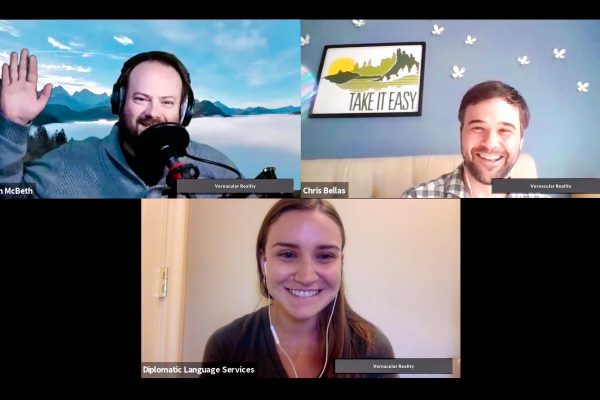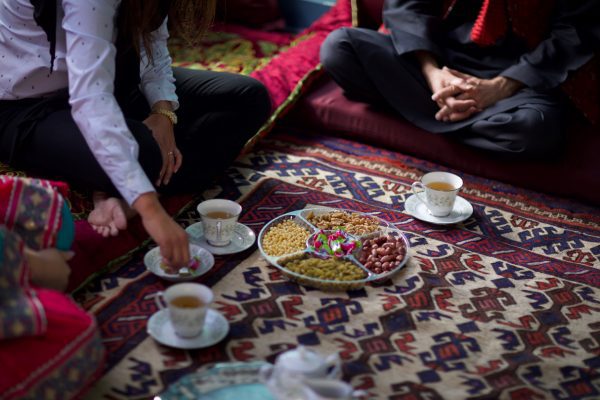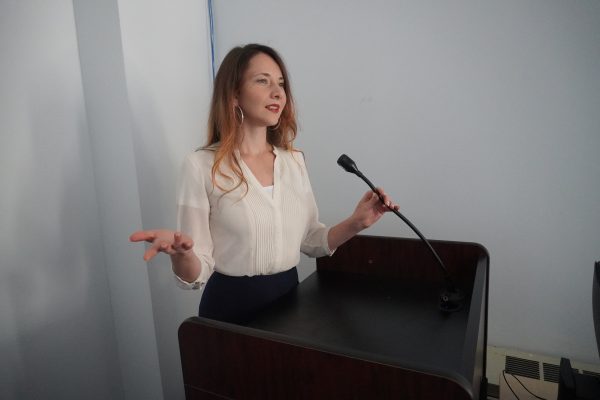Vernacular Reality Podcast Ep. 1 Transcript
Welcome to the first episode of Vernacular Reality! In this episode, our host, Blythe Collins, sits down with Diplomatic Language Services coworkers Sean McBeth (Immersive Software Developer) and Chris Bellas (President). They provide an introduction to DLS and discuss the basics of virtual reality for language learning.
Can you tell the audience a little bit about DLS and our background? What made DLS decide to bring VR into language learning?
Bellas: Diplomatic Language Services was started in 1985 by the former Assistant Dean of the Foreign Service Institute. The business was started to provide individualized, tailored, one-on-one language instruction mostly to foreign service professionals and then eventually, to people in various roles in the government. So, you have a lot of people that might not fit the semester schedule. Other people may have more specific language requirements where they’re traveling to. So, they set up this school, literally across the street from the Foreign Service Institute back in 1985 in Arlington, Virginia, to serve all of those students. Since then, the company has grown. We got into a lot of different other services. In terms of VR, we identified that there was a really good opportunity in that individualized, tailored, one-on-one language instruction that’s really the core of the business.
For those of us who have never used VR, can you give an overview of what it is? How does it differ from AR?
McBeth: So, virtual reality, augmented reality. They’re both parts of different ends of the spectrum of what we call ‘immersive software’. We try to replicate that using technology. We’re able to put a head-mounted display on a person that has LCDs inside of them that allows you to have a view-master look into a fantastical world and move around within it, completely disconnected from where you are in the real world. We can create these different opportunities for people to experience things without necessarily having to travel to them. It’s all about creating new environments that people can bring themselves into and experience things as if they were there. So, that’s virtual reality.
On the opposite end of the spectrum we have augmented reality. Augmented reality has a lot of the same goals of giving people a feeling of the reality of a fantastical object, but we approach it from a different direction. Instead of bringing the user into a fantastical environment, we bring the fantastical elements into the user’s environment. So, you have that bi-directional focus within the immersive software industry of ‘are we asking users to react to something that we’ve created for them, or are we creating something that reacts to the user?’
How did you decide that DLS was ready to move into the VR space?
Bellas:
We got serious when our customers started asking us to look into this. When we first started looking into it, we expected there would be a lot of people that were further down the road on this, in terms of VR/AR applications, language learning, or for what we do: preparing people for an overseas mission. In reality, it turned out that we were early. We could get out in front of this wave if we started paddling.
I remembered how inspired I was when Microsoft HoloLens came out and loved the Minecraft demos. So, I said ‘ok, there probably is a real opportunity here, but we need to design something that is specific for what we do at DLS’. Since what we do is very specific and about each individual student – how can we set them up for success? So, we felt like we needed to bring somebody in who had some vision for that, an appreciation for what we do, and a good understanding of all of the things that the technology can do and make possible.
For me, it wasn’t until I put on the headset and experienced a complete proof-of-concept version of our own product to feel that same inspiration of being put into, in this case, Taxia village in China, and walking around a tulou building and experiencing that firsthand to say ‘I’ve had this experience. This is real, this is immersive in a way that’s congruent with the experiences I had in learning Chinese in college and what I’ve witnessed over the years at DLS.’ I think since then, we’ve been getting really excited about it. We’re looking at ramping it up and bringing somebody on board to help Sean and augment the team. Everybody’s thrilled to be working on this.
McBeth:
I got the call from DLS about being interested in hiring me and I started learning more about the company. It seemed like somebody was writing a fiction about my life – hearing, ‘one of our biggest clients is the Defense Language Institute’. That’s how my parents met, at DLI! That’s how I am a person – because of the need to train people in foreign languages.
We look at the education industry as a whole. There’s a lot of interest in improving learning outcomes and different uses of technology to get students to learn better, more comfortably, faster, or retain knowledge better. There’s a large growing body of science showing that this concept called embodied cognition is a really important tool to bring students down that path of learning. Embodied cognition is the idea of not just dumping information on a student, not just telling them something or giving them a text to read, but engaging them physically and emotionally in activity and activating different cognitive areas within the brain to force that learning to create different neural pathways to be able to dig that information down into someone’s brain.
Just a few years ago, Walmart made big news in the virtual reality industry thanks to a multi-million-dollar contract where they used VR to train warehouse operations – to train people on how to work efficiently and safely within their gigantic logistics machine. So, there’s a lot of big wins that I think we can have in terms of using these virtual environments to teach people things that are difficult to teach just by book learning or are difficult to teach in the real world because they’re expensive to set up or they’re dangerous to do or they’re just not physically available to do.
So, this is particularly timely right now due to the COVID-19 pandemic?
Bellas: When we were planning, designing, and developing this project’s concept, we always had online in mind. The program will perform well, no matter where people are located.
By March 17th, we successfully transitioned all of our in-person classes online. We plan to do that for as long as necessary. We’re fortunate that early on, a lot of student and instructor feedback was positive and focused on thanking us for making the transition swiftly. Since then, the feedback has been that the experience is great. There’s an opportunity with VR.
That connection is valuable in the student and instructor experience. Somebody once told me that you can’t influence an organization that you don’t feel connected to, and I think it’s the same with a person. Many of our student’s missions might suffer if they’re not able to connect with the people in the places that they’re going. In the short run, we want a strong connection between student and instructor, so the learning experience is positive. This is an opportunity to do that. We designed the product not just from a technical perspective, in terms of online. We also made sure that we weren’t disintermediating the good already happening in the classroom between students and instructors.
Another thing somebody told me is the materials make up 10% – 15% of what’s important about the class. The other 80 – 85% is the instructor. So, part of the goal of this product is to empower everyone. We’re excited to use this to enhance the online experience if this continues, in terms of the COVID pandemic. Even when people are in the same building, hopefully, they’ll get excited about the VR portion of their language learning. We’ll have that as an integrated part of their program at DLS, even when conducted in-person.
Can you tell me anything about what you are developing right now?
McBeth: To support enhancing what we already do well, our first concept is this guided tour through a foreign city. So, we have acquired some imagery of a Chinese tourist town and we’ve overlaid lesson material within it. Then, you basically visit this town with your teacher and walk around with them. Meanwhile, they’re giving you a guided tour and role-playing different scenarios. For example, going into a restaurant to buy a meal or asking for directions to a hotel, or buying souvenirs at a market.
It’s really an incredible sort of experience. Technology-wise, it’s a relatively simple technology, but I think sometimes that’s some of the best uses of technology. We’re really just getting to a core idea. I’ve spent so much time testing this app out, I feel like I can get around this town! I know the streets now. Somebody will ask me, as we’re working on it, ‘where was that little kiosk again?’ And I’m like, ‘oh, you go down this street and you turn left, and you go around the corner’. Being able to give a person directions in a town that neither of you has ever been to is amazing. How do you replicate that in another way? I don’t know.
When can we expect to get our hands on this? What’s the plan for the next few months?
Bellas: We’re making improvements to the Taxia village experience and all of the components of our VR system. We’ll continue to make improvements on that for years to come. We’re excited to start integrating virtual reality, starting with the Taxia village, into some of our Chinese language learning programs.
I think part of the benefit and part of why our customers are looking for a language services business to do this is because the integration requires a lot of work. There’s training students and instructors for a new type of experience, as we had to do for the online training. There’s all of the instructional design and curriculum integration that’s beyond me. So, I’m looking forward to seeing that come together to be an integral enhancement of language training. It should make people think, ‘yes, this was a gap for us before’. We’ve filled that gap with VR in a (hopefully) really elegant way. That’s going to help us build out programs for all types of students and needs going forward. As well as setting people up for success in all types of new experiences.
Learn more about DLS Virtual Reality development in the next episode of Vernacular Reality!
For more DLS, check out other blogs and visit us on Facebook, LinkedIn, Instagram, or Twitter!







